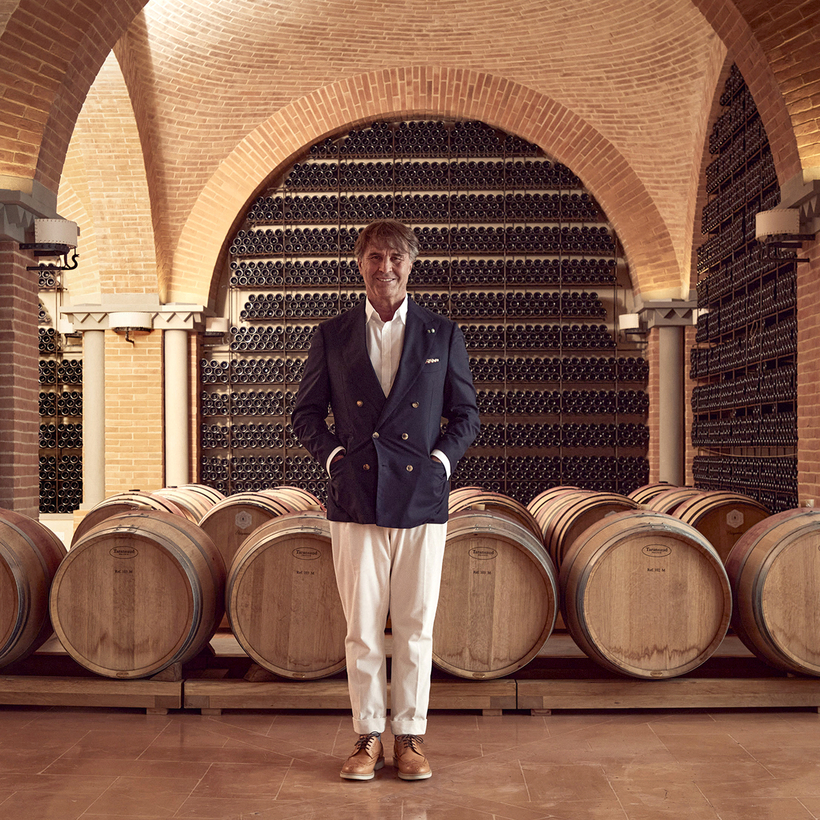Forty years ago, Brunello Cucinelli and his wife, Federica, began restoring and reimagining a crumbling estate in the small Umbrian village of Solomeo. Today, as he stands among the 20,000 vines that were recently planted there, the Italian fashion designer is transported back to the sights and scents of his childhood.
With the wheat field adjacent to the vineyard having just been plowed, “there is only the scent of the churned earth, dried leaves, and wild herbs,” he says. “I don’t want to sound too poetic, but until I was 15, I lived in this kind of environment on my parents’ farm in Perugia, surrounded by the soil. This is where my soul resides.”

Although Cucinelli has a well-known passion for making the sumptuous sweaters and jackets, cobweb-thin skirts, and sequin-flecked knits much loved by movie stars, billionaires, and royals, it’s his love for the land and its spoils that have led him to his most recent pastime, wine-making.
On a recent evening, under the watchful gaze of musical greats—Mozart, Beethoven—frescoed across the vaulted ceiling of the late-19th-century Istituto dei Ciechi in Milan, Cucinelli savored the first sips of his 2018 vintage of Rosso del Castello di Solomeo with what he called a “dinner of gratitude” for family and friends of the brand.
The institute, which has been dedicated to the education and social integration of the blind for the past century, “is a special place for me,” Cucinelli told guests as they ate Umbrian cheeses and salamis, accompanied by slices of toasted bread soaked in his Solomeo estate’s aromatic, viridescent olive oil. “It’s a place filled with humanity and spirituality, home to people who do not see, like Homer the poet, but perhaps have a more eternal vision of the world.”
Though Castello di Solomeo is made with Bordeaux-style Cabernet Franc, Cabernet Sauvignon, and Merlot grapes—planted a decade ago in soil carefully matched to each variety—a dash of Sangiovese wine has been added to the blend in tribute to the culture and wine-making traditions of the area.
The wine was produced with guidance from Riccardo Cotarella, one of Italy’s leading oenologists. (He is also making wine with Sting and Trudie Styler on their Tuscan estate.) Cucinelli’s Rosso del Castello di Solomeo is intense and peppery on the nose but smooth and light on the palate. Its only flaw, said Cotarella, “is that it is young, but it will be here for many, many years to come.”

Under the watchful eye of a statue of Bacchus, the Roman god of wine and pleasure, Cucinelli’s 12-acre vineyard is part of his ambitious Project for Beauty, a vast parkland he has elegantly landscaped across the valley at the foot of the village.
The undulating rows of vines—sinuous in design according to the rules of Renaissance gardens, maximizing access to light and air—have been punctuated with cypress-lined roundabouts as well as walnut and persimmon trees, blazing with what he describes as “dark, intense orange fruit” in November and December. In the summer, the area is filled with deep-red roses.
Cucinelli’s 12-acre vineyard is part of his ambitious Project for Beauty, a vast parkland he has elegantly landscaped across the valley at the foot of the village.
Small bunches of grapes have been left hanging from the vines, as was done when he was a child, for passersby to sample in the autumn. “When I was young, looking after the pigs or the sheep, we would walk among the vineyards and bring some bread and walnuts with us to have with the grapes,” he says. “These are the flavors that have stuck with me since childhood.”
However, the sprightly Cucinelli, who turns 70 next year, has no plans to swap weaving for wine-making anytime soon. “We have these five hectares planted with this red wine and that’s it, full stop,” he says. “The same goes for our production of olive oil or wheat. What we have is just enough.”
And while he might make money from the wine, only a small percentage of the 9,000 bottles produced each year will be sold online, through the Web site Fine+Rare. “Unless we sell the sweaters, there’s no way we can make olive oil and wine. That’s for sure,” he says with a laugh.

As with the company’s collections of clothing, accessories, and housewares, and the Oleo Solomeo olive oil Cucinelli has been producing since 2008, a younger generation is being trained to continue the estate’s legacy of handcrafting.
“Over 50 percent of what we do is made by hand here in Solomeo,” he says. “Every day we are hoeing the soil, pruning the plants, and then harvesting and washing every single grape by hand.... As Xenophanes once said, ‘All things come from earth, and all things end by becoming earth.’ To me, it’s very important to love the place where you come from.”
Fiona McCarthy is a London-based journalist and international contributing editor specializing in art and design. She is a regular contributor to Elle Decoration UK, Vogue Living Australia, and The Times of London, and a co-author of interior decorator Kit Kemp’s best-selling interiors titles, including Design Thread


